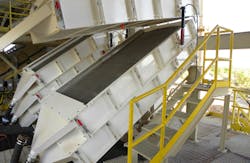Using fine mesh screening to increase roller mill capacity
The operating stages in mineral processing have remained the same for thousands of years.
Crushing and screening is the first controlled size-reduction stage in the process. Reducing the size of minerals, ores, and rocks is almost always accomplished in stages. A classical three-stage crushing approach consists of the following steps:
- Primary Circuit: This is the first crusher in the circuit. It is designed to reduce the largest particle size received at the highest capacity.
- Secondary Circuit: This is the second stage crusher, which typically has a primary function of reducing the material for the next stage of crushing.
- Tertiary Circuit: This is the third stage in crushing. Because gradations are finer at this stage, the crusher must be more accurate to settings and screens must be capable of finer screening.
This three-step approach is necessary to produce a feed source that is small enough to be considered for a fourth stage of crushing known as the grinding stage. Generally, during this stage, your objective is the powdering of the material. Types of mills in this category include air-swept roller mills, various types of ball mills, and hammer mills.
At all stages of crushing and grinding, consideration has to be given to the amount of product-sized particles being created for the next stage in the process. This is especially true for the grinding stage where too many fines lead to overgrinding and mill inefficiencies.
The following Slideshare presentation examines the adverse effect too many fines have on roller mill production and how pre-screening even small amounts of product sized particles can have a significant impact on mill capacity and ultimately on a producer’s bottom line. Efficient fine size reduction—which is often aided through efficient size separation—is one of the most effective investments to reduce cost per ton and increase revenue.
This content is sponsored by Triple/S Dynamics. Sponsored content is authorized by the client and does not necessarily reflect the views of the Process Flow Network editorial team.
To learn more about gravity separators, click here.
